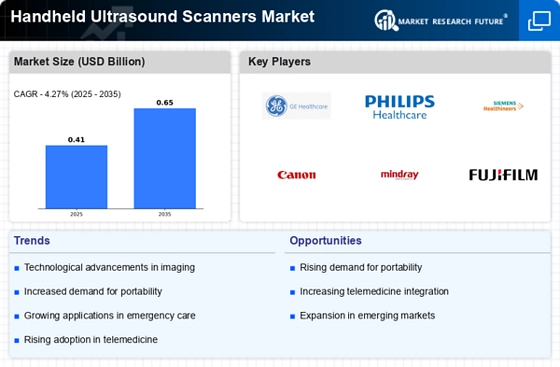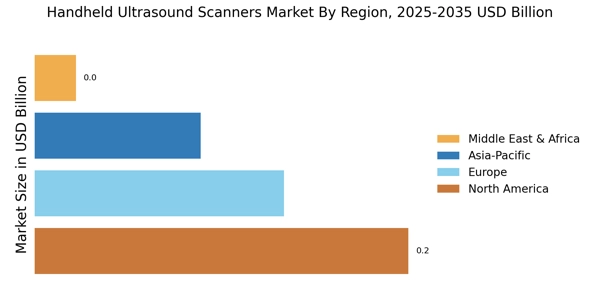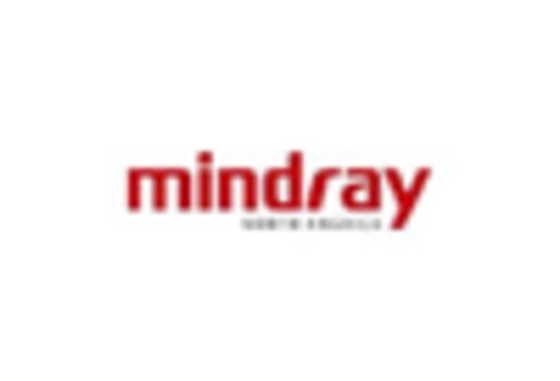Advancements in Imaging Technology
The Handheld Ultrasound Scanners Market is significantly impacted by advancements in imaging technology. Innovations such as improved image resolution, enhanced battery life, and user-friendly interfaces are making handheld ultrasound devices more appealing to healthcare providers. These technological enhancements not only improve diagnostic accuracy but also increase the efficiency of medical examinations. Data suggests that the integration of artificial intelligence in ultrasound imaging is on the rise, further enhancing the capabilities of handheld devices. As these advancements continue to evolve, the Handheld Ultrasound Scanners Market is expected to expand, attracting a wider range of users from various medical specialties.
Rising Prevalence of Chronic Diseases
The Handheld Ultrasound Scanners Market is increasingly driven by the rising prevalence of chronic diseases. Conditions such as cardiovascular diseases, diabetes, and obesity necessitate regular monitoring and timely interventions, which handheld ultrasound devices can facilitate. The ability to perform quick assessments in various settings, including outpatient clinics and home care, makes these devices invaluable in managing chronic conditions. Recent health statistics indicate a steady increase in the incidence of chronic diseases, prompting healthcare providers to seek efficient diagnostic solutions. As the demand for continuous monitoring grows, the Handheld Ultrasound Scanners Market is likely to expand, reflecting the urgent need for accessible and effective healthcare solutions.
Growing Focus on Maternal and Fetal Health
The Handheld Ultrasound Scanners Market is increasingly influenced by the growing focus on maternal and fetal health. Healthcare professionals are recognizing the importance of early and continuous monitoring during pregnancy, which has led to a heightened demand for portable ultrasound devices. These handheld scanners facilitate real-time assessments of fetal development and maternal health, thereby improving prenatal care. Recent statistics indicate that the maternal health technology market is expanding, with handheld ultrasound devices playing a crucial role in this evolution. As more healthcare providers adopt these technologies, the Handheld Ultrasound Scanners Market is likely to see substantial growth, driven by the need for accessible and efficient monitoring solutions in obstetrics.
Rising Demand for Point-of-Care Diagnostics
The Handheld Ultrasound Scanners Market experiences a notable surge in demand for point-of-care diagnostics. This trend is driven by the increasing need for rapid and accurate diagnostic tools in various healthcare settings. As healthcare providers seek to enhance patient outcomes, handheld ultrasound scanners offer a portable solution that allows for immediate imaging and assessment. According to recent data, the market for point-of-care ultrasound devices is projected to grow significantly, with estimates suggesting a compound annual growth rate of over 10% in the coming years. This growth is indicative of a broader shift towards decentralized healthcare, where immediate access to diagnostic tools is paramount. Consequently, the Handheld Ultrasound Scanners Market is poised to benefit from this rising demand, as these devices become integral to routine clinical practice.
Increased Investment in Healthcare Infrastructure
The Handheld Ultrasound Scanners Market is benefiting from increased investment in healthcare infrastructure across various regions. Governments and private entities are recognizing the need for modernized healthcare facilities equipped with advanced diagnostic tools. This investment is particularly evident in developing regions, where the demand for accessible healthcare services is growing. As healthcare systems expand and upgrade, the adoption of handheld ultrasound scanners is likely to rise, as these devices offer a cost-effective solution for improving diagnostic capabilities. Recent reports indicate that healthcare spending is projected to increase, which may further bolster the Handheld Ultrasound Scanners Market as more facilities seek to incorporate these essential tools.


















Leave a Comment